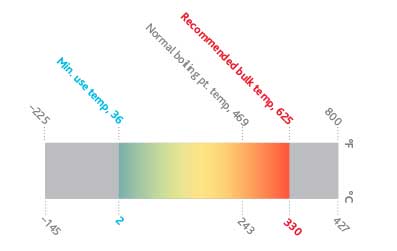Just How Heat Transfer Liquid Adds To Sustainable and Affordable Workflow
In the contemporary commercial landscape, the role of heat transfer liquids (HTFs) in promoting lasting and inexpensive procedures can not be overstated. These fluids are essential in optimizing thermal monitoring systems, therefore substantially boosting power performance and lowering operational expenses. The environmental benefits of advanced HTFs, with their high thermal security and low poisoning, are undeniable. They not only prolong system long life yet also add to the reduction of unsafe discharges. The real possibility of HTFs is recognized through the thorough choice procedure, making certain compatibility and safety and security. However what variables should guide this crucial selection?
Comprehending Heat Transfer Liquids
In the world of thermal management, warmth transfer fluids (HTFs) work as necessary agents for transferring thermal energy from one place to another. These liquids play a critical function in different commercial applications, including chemical handling, power generation, and a/c systems. HTFs are specifically crafted to operate within a large array of temperatures, effectively facilitating the transfer of warm while keeping a stable thermal account. Their capacity to work under severe problems-- whether high temperatures or cryogenic degrees-- makes them vital in settings demanding precise thermal control.
The structure of heat transfer liquids can vary dramatically, consisting of alternatives such as mineral oils, synthetic oils, glycols, and molten salts. Each type supplies distinctive advantages, such as boosted thermal stability, reduced thickness, and high boiling points, which are chosen based on details operational requirements. Moreover, the selection of HTF impacts not just the performance of warmth transfer but also the durability and security of the system in which it is utilized.
As industries continue to innovate, the growth of sophisticated HTFs, defined by their boosted thermal conductivity and decreased environmental impact, is crucial for satisfying the demands of modern thermal monitoring challenges.

Enhancing Energy Efficiency

Improving energy effectiveness has actually come to be a paramount problem throughout different sectors, prompting a better evaluation of heat transfer fluids' function in enhancing thermal management systems. These fluids are indispensable to keeping the wanted temperature in processes, thereby decreasing power waste and boosting total system efficiency. By selecting a suitable warmth transfer fluid, industries can substantially enhance their power efficiency, leading to lowered power intake.

Advanced formulations of warm transfer fluids have actually been created to stand up to severe temperatures while preserving security and performance. Improving power efficiency via optimal warm transfer fluid choice is not only a technical necessity but additionally an environmental critical.
Decreasing Functional Costs
Functional costs are a substantial factor to consider for markets seeking to maintain competitive advantage, and the selection of warm transfer fluid plays an essential function in price monitoring. Choosing a proper warmth transfer liquid can bring about considerable expense financial savings by enhancing system performance and minimizing energy intake. High-performance fluids check this reduce thermal deterioration, which in turn reduces the frequency of liquid substitute and downtime connected with upkeep, thus reducing operational expenditures.
Furthermore, heat transfer fluids with remarkable thermal security and rust resistance extend the lifespan of equipment. This lowers the requirement for frequent repair work and substitutes, which can be expensive and disruptive to procedures. By spending in premium fluids, industries can attain long-lasting decreases in upkeep costs and boost the reliability of their systems.
In addition, progressed warmth transfer liquids frequently display lower thickness at running temperatures, which boosts pump effectiveness and minimizes energy usage in fluid flow. This optimization of power intake directly equates right into decreased functional prices. Moreover, lots of modern-day heat transfer fluids are engineered to run efficiently over a broad temperature level range, minimizing the requirement for numerous liquid kinds, therefore improving stock demands and decreasing associated costs. These aspects collectively add to more sustainable and economical operations.
Environmental Effect Decrease
The press in the direction of lowering ecological effect has obtained energy in markets leveraging heat transfer liquids. Business are progressively identifying the relevance of minimizing eco-friendly impacts by adopting sustainable techniques. Warm transfer liquids (HTFs) play an important function in this change, supplying opportunities to improve energy efficiency and lower discharges. By picking HTFs with high thermal stability and reduced toxicity, industries can make sure very little leak and destruction, therefore more info here decreasing hazardous environmental releases.
Moreover, making use of innovative heat transfer fluids adds to improved system effectiveness, lowering the overall power intake. This decrease not just leads to expense financial savings but additionally reduces carbon dioxide emissions, assisting in the battle versus environment change. Liquids that are biodegradable and recyclable further boost sustainability efforts, as they decrease waste and promote circular economic climate methods.
Furthermore, incorporating HTFs into closed-loop systems prevents fluid loss and contamination of the surrounding environment. This technique makes sure that fluids are recycled, reducing the demand for new sources and limiting waste generation. By embracing these ecologically conscious methods, markets can dramatically diminish their eco-friendly influence while keeping high operational performance, lining up with worldwide sustainability goals and regulatory needs.
Choosing the Right HTF
Picking the suitable warmth transfer fluid (HTF) is an essential action in advancing ecological sustainability within commercial procedures. The option of HTF straight influences system effectiveness, energy consumption, and environmental influence. A suitable HTF needs to possess a high thermal ability, reduced thickness, and high thermal conductivity to guarantee effective warmth transfer. In addition, its stability over a broad temperature level range is important to prevent degradation, which can bring about boosted exhausts and waste.
When selecting an HTF, it is necessary to consider its compatibility with system products to stay clear of rust and chemical responses. This makes certain longevity and minimizes maintenance costs. The fluid ought to be non-toxic and biodegradable, lessening its eco-friendly footprint and making certain conformity with ecological policies. The lifecycle price of the HTF, encompassing purchase, operation, and disposal, need to likewise be assessed to guarantee financial expediency.
Verdict
